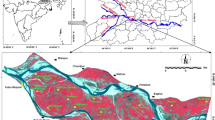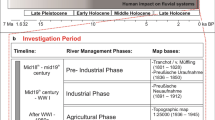Abstract
Hydrogeomorphologically, the study of river meandering provides information on the tendency of rivers to reach and form a state of equilibrium. The process of meander changes is important in order to identify the environment-related causes that occur naturally or vice versa. Sedimentation, erosion, flood, and water quality problems usually are being specifically studied, but in a broad view, changes in the platform of the river affect all the problems that occur. This article discusses the effects of the meanders evolution changes from land use and climate change in the upstream of Sungai Pahang in over 61 years from 1932 to 1993. Based on Geographical Information System (GIS), the topographic maps, scaled to 1:50,000 in geo-reference, were overlaid and digitalized. The main alignments of the upstream reach from those years were superimposed, and the changes were identified based on sinuosity index. In this task, the study areas were divided into two major plots for river plan classification. The results indicated that the average of alignment on the sinuosity index is 1.24 to 1.48 in plot A, while in plot B, the results are not stable. Based on historical results, a very significant change of meander was identified in the subplot Ua3 in plot A, where 21.2 % segments were recorded with high changes. This could be associated with significant exploration at hilly areas in the Cameron Highlands. Large-scale changes in land use pattern are coupled with global climate change where total rainfall recorded was at 2,760 mm in plot A on the year 1993. While for the plot B segment, the percentage of meander changes is 41.5 % versus plot A which is 86.7 %. This is due to the fact that plot B is the forest reserve and national park, areas with natural environment, possessing lithosols characteristic soils in the upper plot B area, and the trend of land use change (forested areas) is substantially lower than in plot A, with a 10 % difference. The aim of this study is to understand the impact of the land use changes due to climatic conditions on the meander evolution changes at the upstream reach of the Pahang River and suggest a number of solutions to mitigate or adaptation strategies to cope with those changes in the future.











Similar content being viewed by others
References
Armas I, Gogoaşe Nistoran DE, Osaci-Costache G, Braşoveanu L (2013) Morpho-dynamic evolution patterns of Subcarpathian Prahova River (Romania). Catena 100(0):83–99. doi:10.1016/j.catena.2012.07.007
Ashmore PE, Rennie CD (2013) Gravel-bed rivers: from particles to patterns. Earth Surf Process Landf 38(2):217–220. doi:10.1002/esp.3361
Aswathy MV, Vijith H, Satheesh R (2008) Factors influencing the sinuosity of Pannagon River, Kottayam, Kerala, India: an assessment using remote sensing and GIS. Environ Monit Assess 138(1–3):173–180
Barry RG, Beckinsale RP, Carson MA, Chorley RJ, Kates RW, Kirkby MJ, Marcus MG, More RJ, Rodda JC, Simons DB, Waltz JP (1969) Introduction to physical hydrology. Methuen & Co Ltd, London
Coulthard TJ, Van De Wiel MJ (2006) A cellular model of river meandering. Earth Surf Process Landf 31:123–132. doi:10.1002/esp.1315, ISSN: 1096-9837
Coulthard TJ, Hicks DM, Van De Wiel MJ (2007) Cellular modelling of river catchments and reaches: advantages, limitations and prospects. Geomorphology 90(2007):192–207. doi:10.1016/j.geomorph.2006.10.030
DID (Department of Irrigation and Drainage) (1974) Pahang River Basin Study, vol. 3: Basin. Hydrology and river behaviour. The Australia Department of Foreign Affairs: Australian Engineering Consultants Snowy Mountain Engineering Corporation
Gasim MB, Toriman ME, Idris M, Lun PI, Kamarudin MKA, Azlina AAN, Mokhtar M, Mastura SAS (2013) River flow conditions and dynamic state analysis of Pahang River. Am J Appl Sci 10(1):42–57. doi:10.3844/ajassp.2013.42.57, ISSN: 1546-9239
Ghani AAb, Chang CK, Leow, CS, Zakaria NA (2012) Sungai Pahang digital flood mapping: 2007 flood. Int J Riv Basin Manag 1–10. ISSN 1571-5124 print/ISSN 1814-2060 online. DOI:10.1080/15715124.2012.680022
Gilvear D, Winterbottom S, Sichingabula H (2000) Character of channel planform change and meander development: Luangwa River, Zambia. Earth 436(4):421–436
Hashim RB, Ishak AMb, Jafri THABM (2007) Laporan Banjir Daerah Pekan Dan Daerah Bera, Pahang Pada 10 Disember 2007. Annual Report of DID Pahang, Malaysia
Hooke JM, Redmond CE (1992) Causes and nature of river planform change. In: Billi P, Hey RD, Thorne CR, Tacconi P (eds) Dynamics of gravel- bed rivers. Wiley, England, pp 557–571
Howard AD (1996) Modelling channel evolution and floodplain morphology. In: Anderson MG, Walling DE, Bates PD (eds) Floodplain processes. Wiley, Chichester, pp 15–62
Kamarudin MKA, Toriman ME, Sharifah Mastura SA, Idris M, Jamil NR, Gasim MB (2009) Temporal variability on lowland river sediment properties and yield. Am J Environ Sci 5(5):657–663. doi:10.3844/ajessp.2009.657.663, ISSN: 1553-345X
Leopold LB, Wolman MG, Miller JP (1964) Fluvial processes in geomorphology. W.H. Freeman, San Francisco
Lun PI, Gasim MB, Toriman ME, Rahim SA, Kamarudin MKA (2011) Hydrological pattern of Pahang River Basin and their relation to flood historical event. Jurnal e-Bangi 6(1):29–37
Mikhailov VN, Kravtsova VI, Magritskii DV (2004) Specific features of development of the modern Sulak River Delta. Water Resour 31(2):133–147
Mstar Published (2007) Mangsa banjir di Pahang meningkat 10,000 mstar online, Wednesday, December 12, 2007
Murray AB, Paola C (1994) A cellular model of braided rivers. Nature 371:54–57
Nossin JJ (1965) The geomorphic history of the Northern Pahang Delta. J Trop Geogr 20:54–64
Othman J, Toriman ME, Sharifah Mastura SA, Gazim MB, Lan PI, Abdullah P, Kamarudin MKA, Abdul Aziz NA (2010) Modeling the impacts of ringlet reservoir on downstream hydraulic capacity of Bertam River using XPSWMM in Cameron Highlands, Malaysia. Res J Appl Sci 5(2):47–53
Pulak D (2012) Meandering nature of Barak River in subtropical climate of Southern Assam, Northeast India—a geospatial analysis. Int J Environ Sci 2:4. doi:10.6088/ijes.00202030094, ISSN 0976 – 4402
Reynolds RC Jr (1971) Clay mineral formation in an alpine environment. Clay Clay Miner 19:361
Richard GA, Julien PY, Baird DC (2005) Statistical analysis of lateral migration of the Rio Grande, New Mexico. Geomorphology 71:139–155
Rinaldi M, Wyzga B, Surian N (2005) Sediment mining in alluvial channels: physical effects and management perspectives. River Res Appl 21:805–828. doi:10.1002/rra.884
Rosgen DL (1994) A classification of natural rivers. Catena 22:169–199
Rosgen DL (1996) Applied river morphology. Wildland hydrology. Pagosa Springs, Colorado
Solihuddin T (2010) Morfodinamika Delta Cimanuk, Jawa Barat Berdasarkan Analisis Citra Landsat. Jurnal Ilmiah Geomatika 16(1):77–85
Stark CP, Barbour JR, Hayakawa YS, Hattanji T, Hovius N, Chen H, Lin C-W, Horng M-J, Xu K-Q, Fukahata Y (2010) The climatic signature of incised river meanders. Science 327:1497–1501. doi:10.1126/science.1184406
Sulaiman WNA, Heshmatpoor A, Rosli MH (2010) Identification of flood source areas in Pahang River Basin, Peninsular Malaysia. Environ Asia 3(SPECIAL ISSUE):73–78
Sulong M, Toriman ME, Aiyub K, Jaafar M (2005) Sungai dan Pembangunan Tebing Sungai Bandar Malaysia. National University of Malaysia Publisher, Bangi
Sun T, Meakin P, Jossang T, Schwarz K (1996) A simulation model for meandering rivers. Water Resour Res 32(9):2937–2954
Sun T, Meakin P, Jossang T (2001) A computer model for meandering rivers with multiple bedload sediment sizes. 2. Computer simulations. Water Resour Res 37(8):2243–2258
Thomas R, Nicholas AP (2002) Simulation of braided flow using a new cellular routing scheme. Geomorphology 43:179–195
Toriman ME (2008) Developing a conceptual model of geomorphic change for channel management proposes: a case of langat river basin. Jurnal e-Bangi 3(3):1–12, ISBN: 1823-884x
Toriman ME, Yusop Z, Mokhtar M, Juahir H (2006) Application of GIS for detecting changes of Sungai Langat channel. Malays J Civ Eng 18(1):58–70
Toriman ME, Kamarudin MKA, Abd Aziz NA, Gasim MB, Idris M, Jamil NR (2009) Modeling the hydrologic-hydraulic of backwater flow and sediment particle saiz analysis in Sungai Chini, Pahang. Jurnal e-Bangi 4(1):56–69, ISBN: 1823-884x
Toriman ME, Kamarudin MKA, Gasim MB, Mokhtar J, Nor Azlina AA, Ia Lun P (2012a) Water quality status and hydrological analysis in upper tropical river, Malaysia. Int J Agric Crop Sci (IJACS) 4(2):33–39, ISSN: 2227-670x
Toriman ME, Kamarudin MKA, Abd Aziz NA, Md Din H, Ata FM, Abdullah NM, Idris M, Jamil NR, Abdul Rani NS, Saad MH, Abdullah NW, Gasim MB, Mokhtar M (2012b) Pengurusan Sedimen Terhadap Sumber Air Bersepadu: Satu Kajian Kes Di Sungai Chini, Pekan, Pahang. Jurnal e-Bangi 7(1):267–283, ISSN: 1823-884x
Toriman ME, Gasim MB, Yusop Z, Shahid I, Mastura SAS, Abdullah P, Jaafar M, Abd Aziz NA, Kamarudin MKA, Jaafar O, Karim O, Juahir H, Jamil NR (2012c) Use of 137Cs activity to investigate sediment movement and transport modeling in river coastal environment. Am J Environ Sci 8:417–423. doi:10.3844/ajessp.2012.417.423, ISSN: 1553-345X
Trimble SW (1993) The distributed sediment budget model and watershed management in the Paleozoic plateau of the upper Midwestern United States. Phys Geogr 14:285–303
Van Hecke S, Van Der Linde L (2011) Cameron highland; discover the history is registered by the Ministry of Home Affairs in Malaysia (KDN). CHH, Kuala Lumpur. ISBN 978-90-817563-2-7
Vipin V, Kumar A, Parashar V, Tomar S (2012) Physical habitat assessment of river denwa using GIS techniques. J Indian Soc Remote Sens 13
Wuriyati A (2007) Tinjauan aspek geometri sebagai terminology di dalam penelitian dan pengembangan teknik sungai. Teknologi Sumber Daya Air 4(3):48–54, ISSN: 1411-5824
Acknowledgments
This research is conducted under the support and funding from the Ministry of Higher Education Malaysia under MyPhD/MyBrain15-KPT-(B) -851207065705. Special thanks are also directed to Professor Dr. Nakamura Masahisa and Dr Nakajima from Shiga University, Japan, Malaysian Remote Sensing Agency (ARSM), Department of Irrigation and Drainage Malaysia (DID), Department of Agriculture of Malaysia (DOA), School of Social Development & Environmental Studies, Faculty of Social Science and Humanities, National University of Malaysia, Department of Environmental Science, Faculty of Environmental Studies, University Putra Malaysia and East Coast Environmental Research Institute (ESERI), and University Sultan Zainal Abidin, Terengganu, Malaysia for their contributions.
Author information
Authors and Affiliations
Corresponding author
Rights and permissions
About this article
Cite this article
Kamarudin, M.K.A., Toriman, M.E., Rosli, M.H. et al. Analysis of meander evolution studies on effect from land use and climate change at the upstream reach of the Pahang River, Malaysia. Mitig Adapt Strateg Glob Change 20, 1319–1334 (2015). https://doi.org/10.1007/s11027-014-9547-6
Received:
Accepted:
Published:
Issue Date:
DOI: https://doi.org/10.1007/s11027-014-9547-6




